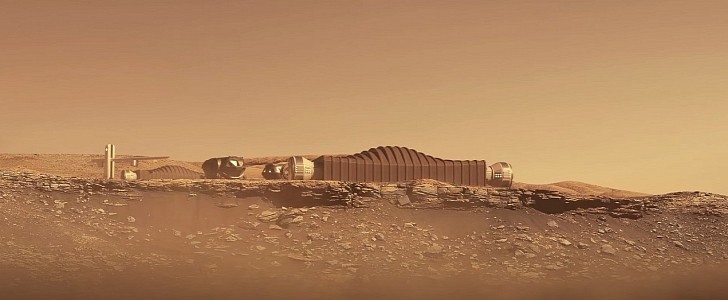It seems like people are getting more and more interested in ditching their home planet and moving to the Red Planet. We’ve yet to land a single human on our cold neighbor, but companies are already rushing to get there and establish entire colonies. In fact, several projects aimed at building cities on Mars are currently underway.
Looks like Elon Musk’s plans to build a sustainable city on Mars by 2050 might not be that far-fetched after all. NASA is also making great efforts to land people on the Red Planet and create Martian cities.
Recently, Texas-based 3D printing company ICON has announced that it has been awarded a subcontract as part of NASA’s The Crew Health and Performance Exploration Analog (CHAPEA) to deliver a 3D-printed habitat at NASA’s Johnson Space Center.
It’s not the first time the space agency collaborates with ICON. Last year, NASA awarded the printing company a contract as part of Project Olympus, which intends to establish a 3D-printed infrastructure for living on the Moon using materials found on its surface.
ICON’s next-gen Vulcan construction system represents a viable solution as the entire setup can meet the requirements necessary to build a base in outer space. Therefore, the space agency went a step further and looked towards Mars.
The structure, called Mars Dune Alpha, will be a 1,700 square-foot (158 square meters) home for the astronauts that will land on the Red Planet. But, until that happens, the 3D-printed building will have to be tested at the NASA Johnson Space Center in Houston by a crew of four individuals isolated together.
Three one-year Mars surface mission simulations will be conducted. The crew will stay in four individual quarters, which will be positioned on one end of the habitat. On the other end, there will be dedicated workstations, medical stations, and food-growing stations.
To avoid spatial monotony and crew member fatigue, the ceiling heights will vary and will be vertically separated by an arching shell structure. NASA will use data from the Mars Dune Alpha simulations to help determine risk and resource trades for future trips to Mars, where astronauts will live and operate for extended periods of time.
“The data gained from this habitat research will directly inform NASA’s standards for long-duration exploration missions, and as such will potentially lay the foundation for a new Martian vernacular. Mars Dune Alpha will take us one step closer to becoming a multiplanetary species,” says Bjarke Ingles, Founder and Creative Director, BIG-Bjarke Ingels Group.
Recently, Texas-based 3D printing company ICON has announced that it has been awarded a subcontract as part of NASA’s The Crew Health and Performance Exploration Analog (CHAPEA) to deliver a 3D-printed habitat at NASA’s Johnson Space Center.
It’s not the first time the space agency collaborates with ICON. Last year, NASA awarded the printing company a contract as part of Project Olympus, which intends to establish a 3D-printed infrastructure for living on the Moon using materials found on its surface.
ICON’s next-gen Vulcan construction system represents a viable solution as the entire setup can meet the requirements necessary to build a base in outer space. Therefore, the space agency went a step further and looked towards Mars.
The structure, called Mars Dune Alpha, will be a 1,700 square-foot (158 square meters) home for the astronauts that will land on the Red Planet. But, until that happens, the 3D-printed building will have to be tested at the NASA Johnson Space Center in Houston by a crew of four individuals isolated together.
Three one-year Mars surface mission simulations will be conducted. The crew will stay in four individual quarters, which will be positioned on one end of the habitat. On the other end, there will be dedicated workstations, medical stations, and food-growing stations.
To avoid spatial monotony and crew member fatigue, the ceiling heights will vary and will be vertically separated by an arching shell structure. NASA will use data from the Mars Dune Alpha simulations to help determine risk and resource trades for future trips to Mars, where astronauts will live and operate for extended periods of time.
“The data gained from this habitat research will directly inform NASA’s standards for long-duration exploration missions, and as such will potentially lay the foundation for a new Martian vernacular. Mars Dune Alpha will take us one step closer to becoming a multiplanetary species,” says Bjarke Ingles, Founder and Creative Director, BIG-Bjarke Ingels Group.








